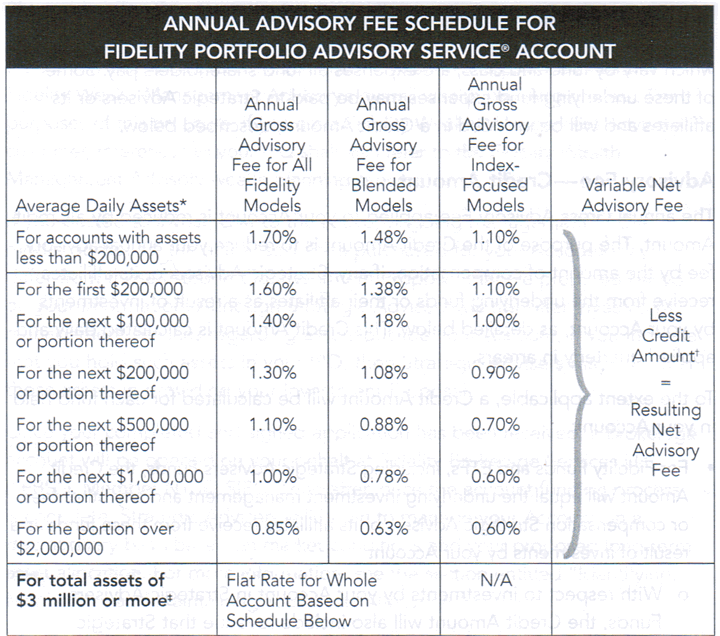
From time to time, people ask to send me details of their current portfolio for some advice. I usually decline respectfully as I don’t feel qualified to provide specific investment advice, but I did accept a copy of the general fee schedule for Fidelity Portfolio Advisory Services (PAS) as of March 30, 2016. Here is a scan of the Annual Advisory Fee Schedule:
Note that the Net Advisory Fee = Gross Advisory Fee – Credit Amount. From the client agreement:
Your Gross Advisory Fee does not include underlying fund expenses charged at the individual fund level for any funds in your Account. These fund expenses, which vary by fund and class, are expenses all fund shareholders pay. Some of these underlying fund expenses may be paid to Strategic Advisers or its affiliates and will be included in a Credit Amount, described below.
In other words, the credit amount is the fees and compensation that your advisors get paid in exchange for picking those investments over the other investments that may not pay such fees. It doesn’t make much difference, as these fees are usually passed onto the retail customers anyway, just indirectly through the mutual fund annual expense ratios. As a result, the gross advisory fee is still the minimum amount that the end customer will pay.
Let’s take a look at what this means:
- For a $1 million portfolio invested in a Fidelity Model asset allocation, you’d be paying 1.27% of your assets to Fidelity on an annual basis in exchange for them managing your portfolio. That’s $12,700 a year automatically deducted from your account.
- For a $1 million portfolio invested in a Fidelity “Index-Focuced” asset allocation, you’d be paying 0.85% of your assets to Fidelity on an annual basis in exchange for them managing your portfolio. That’s $8,500 a year automatically deducted from your account.
- The annual fee above does not include underlying fund expenses. The brochure did not include any specific asset allocations, but this will add another layer of expenses. For example, their Fidelity Strategic Advisers® Core Fund (FCSAX) has an expense ratio of 0.67%.
Consider that many institutions believe that for the next 10-20 years, you’d be somewhat lucky to get a 4% return on balanced portfolio after adjusting for inflation. Put another way, let’s say your $1,000,000 portfolio might provide 4% in inflation-adjusted annual income, or $40,000 a year. With Fidelity PAS, your annual advisory fee of 1.2% would equal $12,700. That would already eat up over 30% of that theoretical income and is before fund expenses. All-in, you’re looking at close to 40% of your potential pre-tax return eaten up by management fees.
Now for my personal thoughts. Briefly, in my opinion, the Fidelity PAS marketing materials (sample brochure) promote their high number of sub-advisors and complexity to suggest that they offer something worth paying a lot of money for. In my opinion, I do not see any evidence that one will receive enough additional return to offset the relatively high fees. While I am a Fidelity self-directed brokerage client and use some of their other products and services, I would not invest my own money in this Portfolio Advisory Service. There are many managed portfolio services like Betterment, Wealthfront, Schwab Intelligent Portfolios, and even all-in-one funds like Vanguard Target Retirement funds which I would recommend my own family members first if they chose not to learn how to do-it-yourself.

 The Best Credit Card Bonus Offers – 2025
The Best Credit Card Bonus Offers – 2025 Big List of Free Stocks from Brokerage Apps
Big List of Free Stocks from Brokerage Apps Best Interest Rates on Cash - 2025
Best Interest Rates on Cash - 2025 Free Credit Scores x 3 + Free Credit Monitoring
Free Credit Scores x 3 + Free Credit Monitoring Best No Fee 0% APR Balance Transfer Offers
Best No Fee 0% APR Balance Transfer Offers Little-Known Cellular Data Plans That Can Save Big Money
Little-Known Cellular Data Plans That Can Save Big Money How To Haggle Your Cable or Direct TV Bill
How To Haggle Your Cable or Direct TV Bill Big List of Free Consumer Data Reports (Credit, Rent, Work)
Big List of Free Consumer Data Reports (Credit, Rent, Work)
Good post and I agree with your comments. Actually, Fidelity fees are little less than most advisors. People need to pay attention and ask their advisor to justify the fees. I had a “discussion” with a advisor who said his fees were 1 1/2 percent. Do the math on 1 year and 10 years.
ALL financial management companies should be required to spell out the expenses, as you did in this article, of what the cost would be WITH a hypothetical example. That would eliminate some but probably not all the nasty surprises.
Thanks for a great blog!